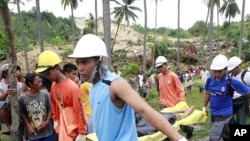In the central Philippines, efforts to rescue victims from Monday’s 6.7-magnitude earthquake in western provinces are being hampered by impassable roads and bridges. There are at least 15 confirmed dead.
The worst-hit area is the island province of Negros where at least one landslide in a mountainside town near the epicenter is believed to have buried dozens of people alive. The Philippine Civil Defense Office says all major roads and bridges to that area are badly damaged and difficult to pass.
Philippine Red Cross Chairman Richard Gordon says without passable bridges, travel times to the landslide-hit town of Guihulngan have greatly increased.
“It should be about an hour, hour-and-a-half, to negotiate that," Gordon explained. "But now they have to go around…which would take another five to eight hours.”
Local officials from the area told reporters their teams were reduced to using their bare hands, picks and shovels to find missing people, as they waited for outside rescuers to arrive. There are reports the military Tuesday sent 400 more troops to the quake-stricken area.
Gordon says residents face other challenges such as a food shortage.
“The market was practically abandoned, and there were freezers there. There was no power so the food was spoiled. The water is not forthcoming because the water system has been destroyed. There’s still no power,” he noted.
The organization is sending food packs, water and shelter supplies to most heavily hit areas near the epicenter.
The quake struck along a fault line that a government seismologist says his office had not previously noted. Seismologist Winchelle Sevilla says a quake of this magnitude came as a surprise.
“Although in the past, we had recorded very few small earthquakes in that region. But these earthquakes did not give any indication that there is an active, overt fault in the area,” Sevilla said.
The government seismic office had recorded more than 900 aftershocks 24 hours after the earthquake struck. Sevilla says diminished aftershocks should be expected for at least another two weeks.
Earthquake Rescue Efforts Continue in Philippines
- By Simone Orendain






